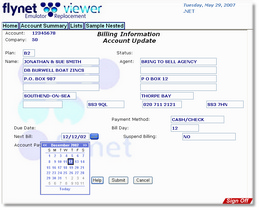
The Flynet 2016 Enhanced UI Generator provides a fast creation of a complete Visual Studio Solution that can optionally mix enhanced ASP.NET web pages with traditional terminal emulation. With Flynet Studio and the Generator, organizations can finally free themselves from the burden of legacy greenscreen interfaces.
Introduced with the Flynet 2013 release is a new boolean option on the UITaskProject, SeparateControlClasses, which when set True will generate a distinct controller class for defined actions and read/writes for the individual ASPX pages. This improves the ability control the user interface actions as well as introduce alternative data integration such as to a relational database.
Introduced with the Flynet 2010 release was the added ability to encapsulate and integrate the Enhanced UI with SharePoint 2010 via the new SharePoint Web Part Generation Option.
Move part or all of your application user interfaces to modern .NET development quickly with low-risk.
The Fastest Way from "Green and Gray" to "Drag-and-Drop"
Before: |
After: |
Upgrade your User Productivity and Workplace Satisfaction
The Enhanced UI Generator is the culmination of years of experience in screen integration tools design and implementation.
With the new Flynet Enhanced UI generator, you can quickly upgrade your user interface to include more intuitive application navigation, data access and data entry.
Dump Your Terminal Emulators
With the Enhanced UI Generator, organizations can replace terminal emulators while providing enhanced views of key screens and applications.
Don't Waste Your Work!
As with the Web Service Generator, the Enhanced UI Framework is a fully editable ASP.NET Visual Studio 2003 or VS2005 solution. Due to its model-view-controller architecture, all work performed on the user interface and business rules of a Enhanced UI solution can be maintained as an asset. The value and relevance of the ASP.NET code will persist, even when the original screen-based transaction system is retired or converted to an alternate platform.
A Bridge to a Better Architecture
Character-based terminal applications have benefits for some organizations; quick deployment, familiar development and direct integration with host databases. Meanwhile, there is an ever widening gap between the richness and versatility of applications built for terminals compared to those built for web delivery or PC GUI implementation.
When compared with the rapid application development possible on the .NET platform, host-based terminal development is not only limited, but due to the strict modality of the terminal screen, it becomes inflexible over time.
If the architecture could be re-factored to one where the host provided a library of web services while the front-end user interfaces were implemented utilizing the full power of the .NET development platforms that would be a very good thing. What is preventing this from happening? First, it is a huge, complex job. Second, constant business requirements continue to flow, driving change through the applications and the change must be implemented in the terminal-based applications because mission critical users are pounding-away every second at those terminals.
The Flynet Enhanced UI ASP.NET Generator can help solve both of these problems by delivering terminal emulation in a converged .NET environment. In this mode, new and/or mission critical sets of screens / workflows can be "sliced-off" to the new architecture while the vast library of existing terminal-based applications remain untouched. We all know that huge, complex jobs are always easier to complete if implemented in small steps. By converging terminal emulation with .NET-based development (and host-based web services), for the first time in the history of terminal emulation, Flynet Viewer technology can make this possible.
Continue reading-- Guide to Application Roles and Behaviors


